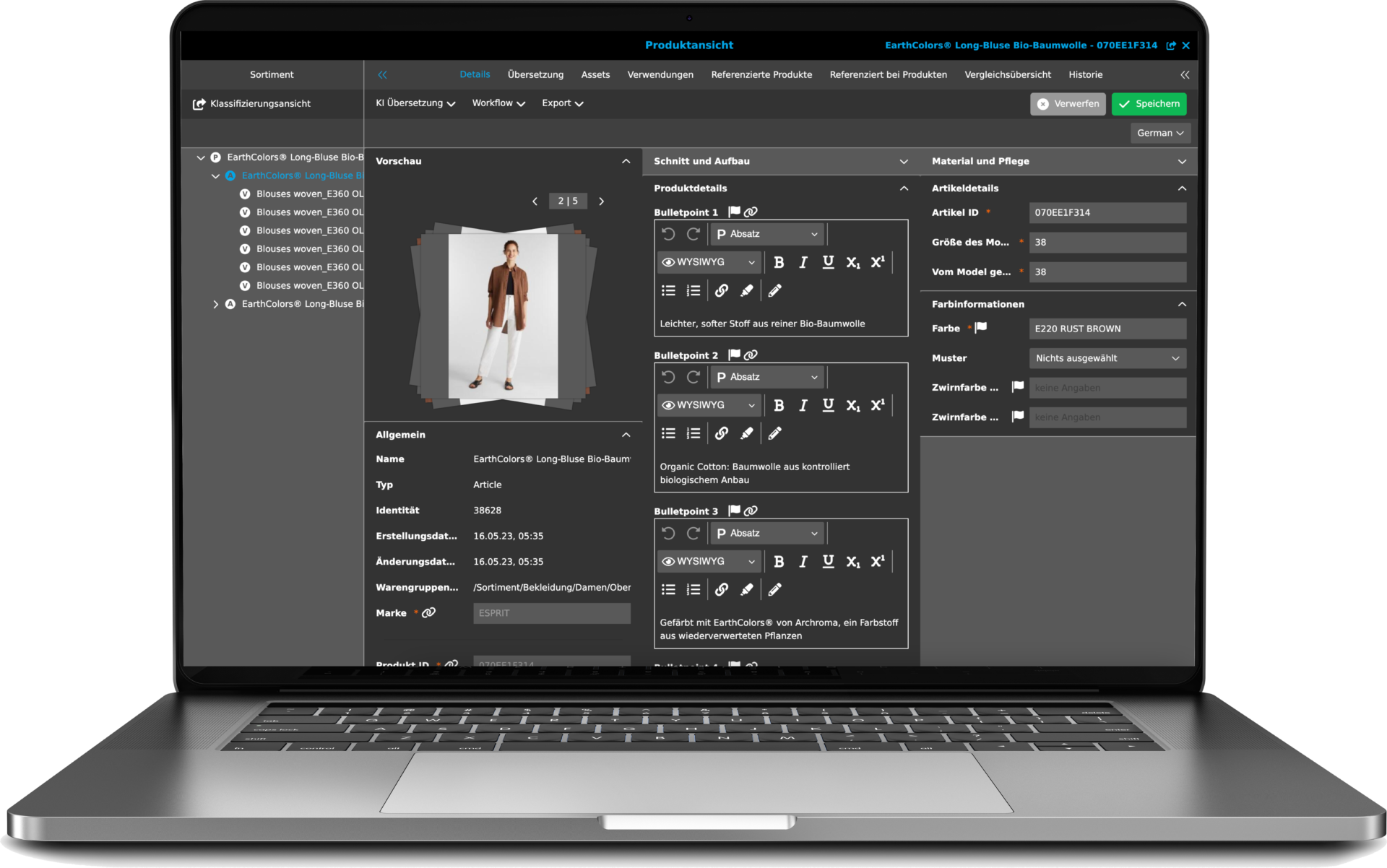Classification of Product Data
Product Information Management
PIM systems are used to store and organise all product-related information centrally and then feed it into the various sales channels. One of the most important functions within the PIM systems is the classification of products. This function makes it possible to organise product information systematically and use it efficiently. In this blog article, we will look at how classification works in PIM systems and what advantages it offers.
What is Classification?
Classification in PIM systems refers to the process of categorising product data into structured categories and groups. This classification is based on common characteristics or attributes of the products, such as type, size, colour, material or intended use. Classification creates a hierarchical structure that makes it easier to search for, compare and manage products. It also facilitates the exchange of product data between manufacturers, retailers, marketplaces and online shops. The result of the classification process is called classification.

Why classify?
If you have a lot of products that you offer, then managing the product data can be quite challenging. This is where classification comes into play, enabling systematic and structured organisation of this data. The decisive reasons for the importance of classifying product data are obvious:
- More efficient data management: By organising products into defined categories, you can manage and update your product information more easily. This is particularly useful when introducing new products or adapting existing product information.
- Increased data consistency: Standardised classification helps you to minimise data errors and ensures that similar products have consistent data. This is particularly important if you manage many products or complex product portfolios.
- Improving interoperability between systems: In the networked business world, in which data is exchanged between different systems and platforms, standardised classification facilitates the flow of data and integration between these systems. This is particularly important if you rely on seamless collaboration between different departments, external partners and systems.
- Improved search and filter functions: By organising your products into clear categories, your customers can find what they are looking for more quickly and efficiently in your online shop. This improves the user experience on digital trading platforms and increases the likelihood of sales.
- Targeted marketing and sales strategies: Classified data allows you to select specific product groups for targeted advertising campaigns or sales promotions. This can lead to more effective marketing strategies and higher sales.
- Optimisation of supply chain and inventory processes: Clearly classified product data helps you to plan and optimise warehousing and logistics. You can better assess which products are needed where and how stocks can be managed efficiently.
- Support for compliance and reporting: In many industries, companies are obliged to keep detailed reports on their products. A clear classification facilitates compliance with legal regulations and reporting to supervisory authorities.
As you can see, by classifying your product data, you can not only optimise your internal processes, but also create a better customer experience and ultimately improve your market opportunities.

Classification using the example of fashion
Ok, it all sounds a bit too theoretical. Here is an illustrative example of the classification of product data in the fashion sector, especially for clothing, shoes and accessories. Using this example, you will quickly see how important a structured organisation is for the efficiency of an online shop.
Main category: Clothing
Subcategory: Ladies
- Tops (T-shirts, blouses, jumpers etc.)
- Trousers (jeans, leggings, shorts etc.)
- Jackets & coats (winter jackets, trench coats etc.)
Subcategory: Men
- Tops (shirts, T-shirts, jumpers etc.)
- Trousers (chinos, jeans, jogging trousers etc.)
- Jackets & coats (parkas, blazers etc.)
Main category: Shoes
Subcategory: Ladies
- Sporty (running shoes, trainers etc.)
- Elegant (pumps, ankle boots etc.)
- Leisure (sandals, espadrilles etc.)
Subcategory: Men
- Business (Oxfords, loafers etc.)
- Sporty (trainers, trail shoes etc.)
- Leisure (sandals, moccasins etc.)
Main category: Accessories
Subcategory: Ladies
- Jewellery (necklaces, earrings, bracelets, etc.)
- Bags (handbags, rucksacks, clutches etc.)
- Hats & caps (baseball caps, Fedora hats etc.)
Subcategory: Men
- Belts (leather belts, fabric belts, etc.)
- Watches (analogue watches, smartwatches, etc.)
- Hats & caps (beanies, panama hats etc.)
The main categories are clothing, shoes and accessories. Each of these categories is further divided into two sub-categories for men and women, which in turn are structured according to product type. To refine the product search and filtering, these subcategories can also be subdivided into attributes such as colour, size, material and brand. As you can see from this example, the effective management of this classification system is only possible with a powerful PIM system, given the great variety and complexity of the product data. A PIM enables you to bring together the wealth of product information centrally and organise it into categories, which significantly improves data consistency and the efficiency of your product management.

Best practices for classification in PIM systems
To maximise the efficiency and accuracy of your product data management, it is crucial that you apply proven methods for classification in PIM systems.
- Development of a standardised classification scheme
A standardised scheme that takes industry-specific standards into account is crucial. It should be flexible enough to accommodate new products or categories without having to overhaul the entire system. - Use of attributes for fine classification
In addition to main categories, products should also be classified according to specific attributes. This enables more detailed filter and search functions and improves product data quality. - Integration with other systems
Classification should be seamlessly integrated with other company systems such as ERP (Enterprise Resource Planning) and CRM (Customer Relationship Management) to ensure a continuous flow of information. - Regular review and adjustment
The classification scheme should be regularly reviewed and adapted to ensure that it meets current market requirements and covers all relevant product characteristics.

An overview of leading classification standards
By the way. There are special classification standards that provide a standardised language for the description, exchange and management of product and service information. Below are some leading classification standards that have been developed by various initiatives, associations and organisations with different interests and origins.
- ECLASS: This internationally widespread standard enables the cross-border digital exchange of product master data across industries, countries and languages. With over 48,000 classes and over 23,000 unique features that require only four classification levels for categorisation, ECLASS offers a comprehensive basis for product classification and communication.
- ETIM: ETIM, short for Electrotechnical Information Model, is the classification standard for electrical engineering and related industries such as HVAC and sanitary engineering. Originally developed for electrical installation products, consumer electronics and household appliances, ETIM now also supports building information modelling (BIM). The standard has been designed to allow seamless integration with other industry standards such as ECLASS. Data transfer is supported by BMEcat, an XML-based format for the exchange of electronic catalogue data.
- GPC – GS1: The Global Product Classification (GPC) standard has been published by GS1 (Global Standard 1) since 2003 and is an integral part of the Global Data Synchronisation Network (GDSN). GS1, a non-profit organisation primarily active in the retail sector such as clothing, food and FMCG, issues the GTIN – formerly known as EAN (European Articel Number) – as well as other unique identification numbers for products, locations and assets. The GPC standard, which has become established primarily in the English-speaking world through co-operation within the framework of the United Nations, offers not only the classification level but also lists of characteristics and values that can be used to describe products in detail.
- USNPSC: The United Nations Standard Products and Services Code (USNPSC), introduced in 1998, is a widely used classification standard in the US market that has its origins in the field of merchandise management. This standard enables all products and services to be clearly categorised. In addition, the “IDEA Electrical Attribute Schema” allows a limited standardisation of features.
Summary: Classification of Product Data
Classification in PIM systems is more than just an administrative task; it is a central component of a company’s product strategy. Through effective classification, you can not only optimise your internal processes, but also create a better customer experience and ultimately increase your sales. It is therefore important to pay due attention to this aspect when planning and implementing PIM systems. And if you’re thinking about introducing a PIM, then you’ve come to the right place.
Our specially developed OMN PIM not only fulfils all the PIM functions such as classification that you need to market your products. It is also equipped with the latest AI technology to automate time-consuming and cost-intensive manual processes. You can even create intelligent, SEO-optimised product descriptions with our OMN PIM. The open interfaces ensure seamless integration of our OMN PIM into existing environments (e.g. online stores, marketplaces, ERP or PLM systems) to enable smooth data exchange. A proven PIM system of the latest generation! Please feel free to contact us. Our PIM experts will be happy to advise you and present our OMN PIM to you in a personal and non-binding demo.

Do you know our PIM system “OMN PIM”?
CONTACT US WITHOUT OBLIGATION AND LET US CONVINCE YOU OF OUR OMN PIM.